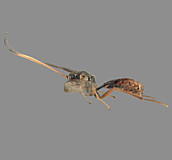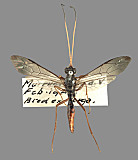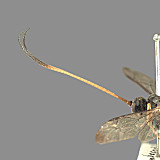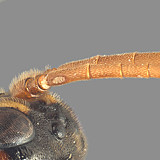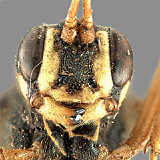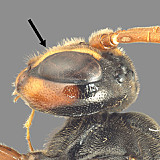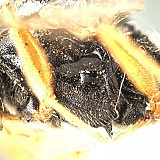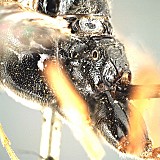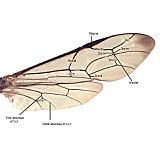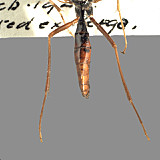Pergaphaga iangauldi Cammack and Wharton, 2010
The following additional variation was noted among members of the type series: in one female, the flagellum is brown basally rather than orange, the epicnemial carina does not extend dorsally to the level of the ventral corner of the pronotum in several specimens, and in the left hind wing of one of the females, Cu1 is 1.15 times longer than 1cu-a. The female paratype from Canberra has a slightly different color pattern than the series from Murrumbeena, but unlike the specimen from Bright, sculpture and venation are the same and it is therefore included in the paratype series to emphasize color variation in this species. In the Canberra specimen, T2 and all following metasomal terga are black medially, face and clypeus are brownish yellow medially, fore and mid coxae are orange ventrally, and first 32 flagellomeres are orange.
One male specimen lacks a fore wing areolet in both wings. In the left wing, it is easier to see that that the absence of an areolet is due to the fusion of 2rs-m and 3rs-m rather than the loss of one or the other of these. This suggests that within Pergaphaga, at least, there is a trend toward gradual loss of the areolet through reduction in size and fusion of the adjacent cross-veins.
The paratype from Canberra is also the voucher specimen for the Pergaphaga sequence reported in Quicke et al. (2009).
This species is named for Ian Gauld for his significant contribution to the understanding of this genus and the Westwoodiini in general.
Pergaphaga iangauldi lacks the elevated median flange on the frons (Fig. 7) as found in P. nigra and P. xanthops. The shared loss of the elevated flange is the most distinctive feature supporting the sister-group relationship between P. iangauldi and P. leaski Wharton. In addition to differences in antennal color pattern, P. iangauldi has a more heavily sculptured mesopleuron (Fig. 8) than P. leaski. Pergaphaga leaski has a uniformly black antenna.
Pergaphaga iangauldi, P. leaski, and P. xanthops form a well-supported clade relative to P. nigra, characterized by reduced body sculpture (e. g. Fig. 9), reduced fore wing areolet (Fig. 10), and the pattern of pale coloration on the face, legs, and metasoma (Figs 5, 6, 11).
Type material. Holotype. Female (MVMA), with labels as follows: “Murrumbeena. V./ Feb. 1948./ Bred ex Perga.” [handwritten] “Collection/ A. N. Burns” [printed] “ENT – 935” [printed] “MUS. VIC./ ENT-1089” [printed] “HOLOTYPE/ Pergaphaga/ iangauldi/ Cammack & Wharton” [red, handwritten
Paratypes: 3 females, 2 males, same data as holotype, one of these with an additional Certonotus identification label (MVMA); 1 female, New South Wales, Windsor, Bred by B. A. Hill, 29.xii.97, Ex. Coll. Nat. Mus. (MVMA); 1 female, ACT, Canberra, The Pinnacle, Hawker, 35º16’S, 149º02’E, 6-23.×.2002, K.P. Bland.
Other specimen examined (not a paratype): 1 female, Victoria, Bright, H.W. Davey (QM).
Remarks: The first two labels on the paratype from Windsor are handwritten. The first is difficult to read, with the month, day, and locality legible, but the remainder difficult to decipher and possibly misinterpreted. The second label is completely illegible. This and the specimen from Bright bear Pergaphaga det. labels by I. D. Gauld dated 1984.
This work would not have been possible without the groundwork provided by Ian Gauld’s study of the Australian fauna, including the initial recognition of the Pergaphaga iangauldi as an undescribed species. We are particularly grateful for his assistance in many aspects of this study. We also thank the following curators and researchers for extended loans of the material used for this revision: John LaSalle (ANIC), Ian Gauld (deceased) and Gavin Broad (BMNH), Ken Walker (MVMA), and Chris Burwell (QMBA). Donald Quicke also kindly sent us the specimen he sequenced as part of his study on the molecular phylogeny of Ichneumonidae. We thank David Wahl of the American Entomological Institute (AEIC) for permission to use material previously published in the Contributions of the American Entomological Institute, as well as for useful feedback throughout our study of Westwoodiini. Matt Yoder provided considerable assistance with databasing issues, and our use of PURLs (http://purl.oclc.org) in this regard follows the example of their use in publications by Norm Johnson. Heather Cummins also graciously assisted us with image processing, formatting, and literature retrieval. This revision was conducted at Texas A&M University and is based upon work supported by the National Science Foundation’s PEET program under Grant No. DEB 0328922 and associated REU supplement nos DEB 0723663 and DEB 0522836. Page last updated October 2010.
This material is based upon work supported by the National Science Foundation under Grant Number DEB 0328922 with REU supplement DEB 0723663 and DEB 0522836.
Any opinions, findings, and conclusions or recommendations expressed in this material are those of the author(s) and do not necessarily reflect the views of the National Science Foundation.

